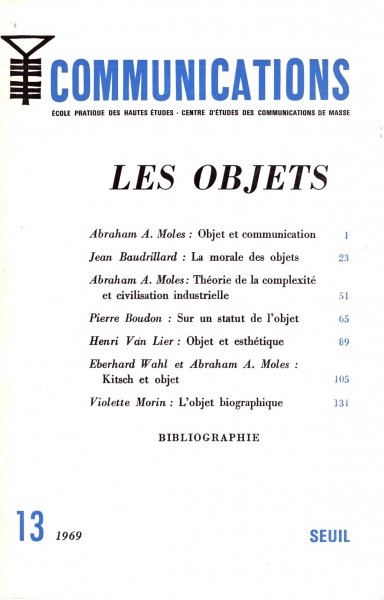Jakob von Uexküll: A Foray Into the Worlds of Animals and Humans: A Picture Book of Invisible Worlds (1934–) [DE, EN, FR]
Filed under book | Tags: · animal, biology, environment, meaning, nature, perception, philosophy, plants, psychology, semiotics, subjectivity, time, umwelt

““Is the tick a machine or a machine operator? Is it a mere object or a subject?” With these questions, the pioneering biophilosopher Jakob von Uexküll embarks on a remarkable exploration of the unique social and physical environments that individual animal species, as well as individuals within species, build and inhabit. This concept of the umwelt has become enormously important within posthumanist philosophy, influencing such figures as Heidegger, Merleau-Ponty, Deleuze and Guattari, and, most recently, Giorgio Agamben, who has called Uexküll “a high point of modern antihumanism.”
A key document in the genealogy of posthumanist thought, A Foray into the Worlds of Animals and Humans advances Uexküll’s revolutionary belief that nonhuman perceptions must be accounted for in any biology worth its name; it also contains his arguments against natural selection as an adequate explanation for the present orientation of a species’ morphology and behavior. A Theory of Meaning extends his thinking on the umwelt, while also identifying an overarching and perceptible unity in nature. Those coming to Uexküll’s work for the first time will find that his concept of the umwelt holds new possibilities for the terms of animality, life, and the framework of biopolitics.”
German edition
With illustrations by George Kriszat
Publisher J. Springer, Berlin, 1934, 102 pages
New edition, with the essay “Bedeutungslehre”, with a Foreword by Adolf Portmann, Rowohlt, Hamburg, 1956, 182 pages
English edition
Translated by Claire H. Schiller
In Instinctive Behavior: The Development of a Modern Concept, pp 5-80
Publisher International Universities Press, New York, 1957
Reprinted in Semiotica 89(4), 1992, pp 319-391
New English edition, with the essay “A Theory of Meaning”
Translated by Joseph D. O’Neil
Introduction by Dorion Sagan
Afterword by Geoffrey Winthrop-Young
Publisher University of Minnesota Press, 2010
Posthumanities series, 12
ISBN 9780816658992
272 pages
Reviews and commentaries: Levi R. Bryant (2010), Robert Geroux (Humanimalia, 2012), Franklin Ginn (Science as Culture, 2013).
Streifzüge durch die Umwelten von Tieren und Menschen (German, 1934)
Streifzüge durch die Umwelten von Tieren und Menschen. Bedeutungslehre (German, 1934/1956)
A Stroll Through the Worlds of Animals and Men (English, trans. Claire H. Schiller, 1957)
A Stroll Through the Worlds of Animals and Men (English, trans. Claire H. Schiller, 1957/1992)
Mondes animaux et monde humain suivi de La théorie de la signification (French, trans. Philippe Muller, 1965)
A Foray Into the Worlds of Animals and Humans, with a Theory of Meaning (English, trans. Joseph D. O’Neil, 2010)
See also chapters 10-11 of Agamben’s The Open: Man and Animal: Umwelt; Tick (2002/2004)
Comment (0)Moles, Baudrillard, Boudon, van Lier, Wahl, Morin: Les objets (1969/71) [French, Spanish]
Filed under book | Tags: · 1968, aesthetics, design, object, philosophy, political economy, psychology, semiotics, sociology, theory

Communications is a biannual social sciences journal founded by Georges Friedmann, Roland Barthes, and Edgar Morin. Soon after its start in 1961 it became a reference publication for media studies and semiotics in France and internationally.
Its first 1969 issue was dedicated to the theory of objects, positioning it “at the confluence of sociology, political economy, social psychology, marketing, philosophy, design and aesthetics” (p 141). At the same time the journal argued for the relevance of the study of objects for governmental institutions such as “the Ministry of Industrial Production, the Ministry of Transport, the customs authorities, the courts, the counterfeits studies, or the National Industrial Property Institute” (p 141).
It can be read as a post-May 1968 attempt to use the concept of object as an agent linking social sciences in order to increase their impact on direct political change, and as well as an early echo of what more than a decade later came to be known as the actor-network theory.
Two years later the magazine appeared in its Spanish translation in book form.
Communications 13
Publisher Centre d’études des communications de masse, École pratique des hautes études, and Seuil, Paris, 1969
139 pages
Les objets (French, 1969), View online
Los objetos (Spanish, trans. Silvia Delpy, 1971/1974)
Jean-François Augoyard, Henry Torgue (eds.): Sonic Experience: A Guide to Everyday Sounds (1995/2006)
Filed under book | Tags: · acoustics, city, everyday, listening, music, psychology, sound

“Never before has the everyday soundtrack of urban space been so cacophonous. Since the 1970s, sound researchers have attempted to classify noise, music, and everyday sounds using concepts such as Pierre Schaeffer’s sound object and R. Murray Schafer’s soundscape. Recently, the most significant team of soundscape researchers in the world has been concerned with the effects of sounds on listeners.
In a multidisciplinary work spanning musicology, electro-acoustic composition, architecture, urban studies, communication, phenomenology, social theory, physics, and psychology, Jean-François Augoyard, Henry Torgue, and their associates at the Centre for Research on Sonic Space and the Urban Environment (CRESSON) in Grenoble, France, provide an alphabetical sourcebook of eighty sonic/auditory effects. Their accounts of sonic effects such as echo, anticipation, vibrato, and wha-wha integrate information about the objective physical spaces in which sounds occur with cultural contexts and individual auditory experience. Sonic Experience attempts to rehabilitate general acoustic awareness, combining accessible definitions and literary examples with more in-depth technical information for specialists.”
First published À l’écoute de l’environnement: Repertoire des effets sonores, Editions Parenthèses, 1995
English edition
With a Foreword by R. Murray Schafer
Translated by Andra McCartney and David Paquette
Publisher McGill-Queen’s University Press, 2006
ISBN 0773576916, 9780773576919
230 pages
Review: Kate Galloway (U Toronto Quarterly, 2007).
Comment (1)
